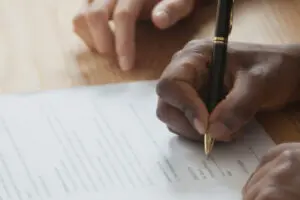The question, “What proof do you need for a restraining order?” is commonly asked but rarely, it seems, thoroughly understood.
Evidence like documented injuries or threats, recorded messages, written statements and credible witness accounts are generally crucial. This article offers a focused breakdown of the specific types of proof required and how to effectively compile them for your petition. Here’s what you need to know:
- A restraining order requires evidence of harm or a threat of harm with varying standards such as a preponderance of evidence for domestic violence cases and clear and convincing evidence for civil cases.
- Documentation of incidents, witness testimonies, and communication records are crucial forms of evidence that can strengthen a restraining order case and must be meticulously gathered and prepared.
- Navigating the legal process of obtaining a restraining order involves multiple steps, from filing for a temporary order to preparing for a permanent order hearing, with potential legal consequences for the respondent upon granting.
Proofs you need for a Restraining Order
To successfully obtain a restraining order, specific types of evidence are crucial. These include documented incidents, witness testimonies, and tangible physical evidence.
Detailed Incident Documentation
It’s imperative to meticulously document all instances of abuse or harassment, noting the specifics of each event and preserving any threatening communications like voicemails, emails, or text messages. Such documentation establishes the immediate and ongoing danger necessary for a restraining order.
Witness Testimonies and Affidavits
Witness accounts significantly strengthen your case. Individuals who have observed the abuse or harassment can provide vital support through written statements, affidavits or by testifying at the hearing. Their corroboration presents a compelling argument to the judge for the issuance of a restraining order.
Physical Evidence: Photographic and Audiovisual
Capturing physical evidence of the abuse, whether through photos, videos, or audio recordings, is essential. Audio recordings can be used to document verbal threats or altercations. Additionally, showing the extent of any injuries with visual evidence can underscore the severity of the threat and the need for protection.
Understanding Restraining Orders
A restraining order is a court-issued directive that restricts certain actions of the respondent, primarily to prevent further physical harm resulting from violence or threats. It’s not just a piece of paper; it’s a tool for legal and police protection against current or past abuse or potential harm. But how does one obtain such an order, and what evidence is required?
Despite any initial apprehensions, the process of a restraining order request, including temporary restraining order requests, is relatively straightforward. Judges commonly request evidence of harm or threat of harm to grant a restraining order. This evidence could range from testimony, documents, to communication records that corroborate the allegations made in the petition. Restraining orders, though, can vary in duration – from temporary to permanent, depending on the evidence presented and the legal decision regarding the need for ongoing protection.
According to a 2017 study from the CDC’s National Intimate Partner and Sexual Violence Survey (NISVS), one in three women and one in four men have experienced severe physical violence from an intimate partner during their lifetime. Understanding the gravity of these statistics, Duncan Family Law is committed to providing compassionate and effective legal support to those affected by such violence.
Domestic Violence Restraining Order

When confronted with domestic violence – a truly terrifying ordeal – a domestic violence restraining can be a lifeline. This protective order also covers relationships such as:
- spouses
- co-habitants
- a dating couple
- people with children together
Obtaining this order requires a preponderance of evidence, meaning the facts alleged are more likely than not to have occurred. This standard involves demonstrating that instances of violence or sexual assault have indeed taken place.
An important aspect to remember is that, even after a temporary restraining order expires, its documentation remains with the police and courts, ensuring ongoing protection.
Civil Restraining Order
While domestic violence orders are intended for intimate relationships, what about threats from others? Enter the civil restraining order, aimed at providing protection from harassment or threats from other individuals, like neighbors or business partners.
Obtaining a permanent civil restraining order requires clear and convincing evidence – a higher standard compared to domestic violence orders. In a civil restraining order case, this evidence includes a continuing course of conduct that encompasses stalking or harassment, a credible threat of violence, and reasonable proof that the conduct resulted in physical harm.
Physical evidence like photos or medical records that document the actual physical harm or sexual assault, as well as witness statements verifying the abuse, can be extremely valuable to enforce restraining orders.
Gathering Evidence for a Restraining Order

Evidence is the cornerstone of any restraining order case. Strengthening the case comprehensive documentation of incidents, secure witness testimonies, and maintain communication records appropriately.
The quality of evidence often determines the success of the case. This is because strong, compelling evidence can convincingly demonstrate the harm or threat of harm, increasing the chances of the order being granted. The question then arises – how to assemble this evidence? The following subsections will guide you through this process.
Documenting Incidents
A solid case begins with meticulous documentation of incidents. This not only includes recording specific details of the respondent’s actions but also capturing any threats made, preferably in verbatim. Accurate recording of the dates and locations of each occurrence is equally important.
Thus, you might wonder what the most effective methods for documenting incidents are. One way is to gather evidence such as pictures and communication records like text messages and emails, and ensure to print out copies of each piece of evidence. Additionally, maintaining a journal or diary can create a chronological record of the abusive behavior, thereby establishing a persistent pattern of domestic violence and strengthening the case.
Witness Testimonies
In a restraining order case, witness testimonies can significantly improve the odds of success. They offer accounts from individuals with knowledge of the incidents, providing supplementary evidence to support allegations and contribute to building the most robust case possible.
What then, constitutes a strong witness testimony? Essentially, a witness must be able to testify to pertinent incidents, offer corroborating evidence, and be ready to discuss their personal background and connection to the individuals involved. It’s also important to ensure that witnesses are available and prepared for the hearing, and all required evidence and documentation are ready for presentation.
Communication Records
In a restraining order case, communication records play a pivotal role as evidence. They can help establish a pattern of threats or harassment and hence are of utmost importance. Forms of communication that can be admitted as evidence include:
- Recordings
- Text messages
- Emails
- Testimony from witnesses
These records can be preserved using tools like Decipher TextMessage, or by taking screenshots.
Emails and messages can also be used as evidence, especially if they depict harassment or threats. Voicemails can be recorded using an audio recorder app and saved in the cloud for extra safety.
Navigating the Legal Process
The journey through the legal process to secure a restraining order can be intricate. It involves filing a temporary order, preparing for the permanent order hearing, and understanding the consequences of the.
Although a personal court appearance isn’t mandatory to secure a temporary, it’s essential to consult a legal expert after receiving a temporary restraining order to effectively prepare for the upcoming court hearing within the court system. Understanding these steps is key to ensuring that the process is handled accurately and efficiently.
Filing a Temporary Restraining Order
The initial step to obtaining legal protection is filing a temporary restraining order. This involves:
- Submitting the required court forms to the court clerk.
- While the specifics may differ depending on the jurisdiction, this process can generally be pursued without the involvement of an attorney.
- Any assistance required in completing the forms can be sought from the court.
Upon submitting a temporary restraining order, it’s necessary to fill out a proof of personal service and any other jurisdiction-specific forms. The process may seem daunting, but with the right guidance and preparation, it can be navigated effectively.
Preparing for the Permanent Restraining Order Hearing
Once the temporary order is in place, the next step is to prepare for the permanent restraining order hearing. This involves presenting a clear and convincing case to the judge, demonstrating your organization and seriousness about the need for protection.
Preparing for the hearing necessitates:
- Thorough review of the court papers
- Strategizing the statements to be presented to the judge
- Documenting key facts and details that bolster your case
- Bringing notes for reference and any physical evidence that bolsters your case
- Identifying any witnesses who can testify on your behalf
Consequences of a Restraining Order
Once a restraining order is granted, it brings about certain legal implications for both the petitioner and the respondent. For the petitioner, it provides a legal safeguard against potential harm, with the respondent required to adhere to the imposed limitations.
For the respondent, breaching the order can lead to repercussions such as contempt of court sanctions, the imposition of further restrictions, or the initiation of proceedings. The order can also impact the respondent’s criminal record and restrict their communication with the petitioner and their rights to own firearms.
MORE DETAILS IN OUR ARTICLE: Does a Restraining Order Go on Your Record?
Seeking Legal Assistance

Even though managing the restraining order process independently is feasible, considering the help of a family law or domestic violence attorney could lead to a more favorable outcome. An attorney can offer legal representation, develop a strategy to safeguard your rights, and attain favorable results.
This section will provide guidance on finding the right lawyer and what to expect during the initial consultation.
Finding the Right Lawyer
Finding the right lawyer can make a significant difference in your case. A seasoned criminal defense attorney who specializes in restraining order cases can provide the expertise needed.
However, legal representation comes at a cost. Proficient attorneys typically charge between $275 and $450 per hour, with clients expected to cover a minimum of five to ten hours of the attorney’s time. You can find experienced lawyers for restraining order cases on reputable online platforms such as LegalMatch and LegalAtoms.
Initial Consultation
The initial consultation with a lawyer presents an opportunity to talk about your situation, evidence, and legal avenues. It is crucial to prepare for this meeting, carefully planning your account of the events, and bringing any pertinent evidence or witnesses.
Ask questions about the implications of a restraining order and the types of restraining orders that can be requested. The lawyer will provide legal advice, guidance, and detailed information about the restraining order process. The initial consultation typically lasts approximately 20 minutes to an hour.
Summary
Navigating the process of obtaining a restraining order can be a daunting task, but with the right knowledge and guidance, it can be made manageable. This blog post has provided a comprehensive guide on the types of restraining orders, the essential evidence required, and how to navigate the legal process.
Remember, seeking legal assistance from a family law or domestic violence attorney can be a valuable step in ensuring that your rights are protected and that the process is handled accurately and efficiently. Stay informed, stay prepared, and take the necessary steps to ensure your safety and well-being.
Our domestic violence lawyers at Duncan Family Law are dedicated to ensuring the safety and legal rights of all individuals in these challenging situations, offering expert guidance and representation.
If you feel threatened or are in immediate danger please call 911 to seek immediate help.
Frequently Asked Questions
What is the burden of proof for a restraining order in New Jersey?
In New Jersey, the burden of for a restraining order is a “preponderance of evidence” civil standard, which means a 51% burden of proof on the plaintiff.
What proof do you need for a restraining order in Tennessee?
In Tennessee, you need a verified complaint or affidavit clearly showing that your rights are being or will be violated and that you will suffer immediate and irreparable injury to obtain a restraining order.
What proof do you need for a restraining order in Nevada?
In Nevada, you need to prove that the abuser has committed an act of domestic violence and demonstrate to a judge that you require the protection requested in the petition. Be prepared to provide evidence and make a compelling case.
What types of restraining orders exist?
There are mainly two types of restraining orders: Domestic Violence Restraining Order and Civil Restraining Order, each covering different types of relationships and providing different forms of protection.
What evidence is required for a restraining order?
To obtain a restraining order, you will need documentation of incidents, witness testimonies, and communication records that prove harm or threat of harm. This evidence is crucial in supporting your request for a restraining order.






